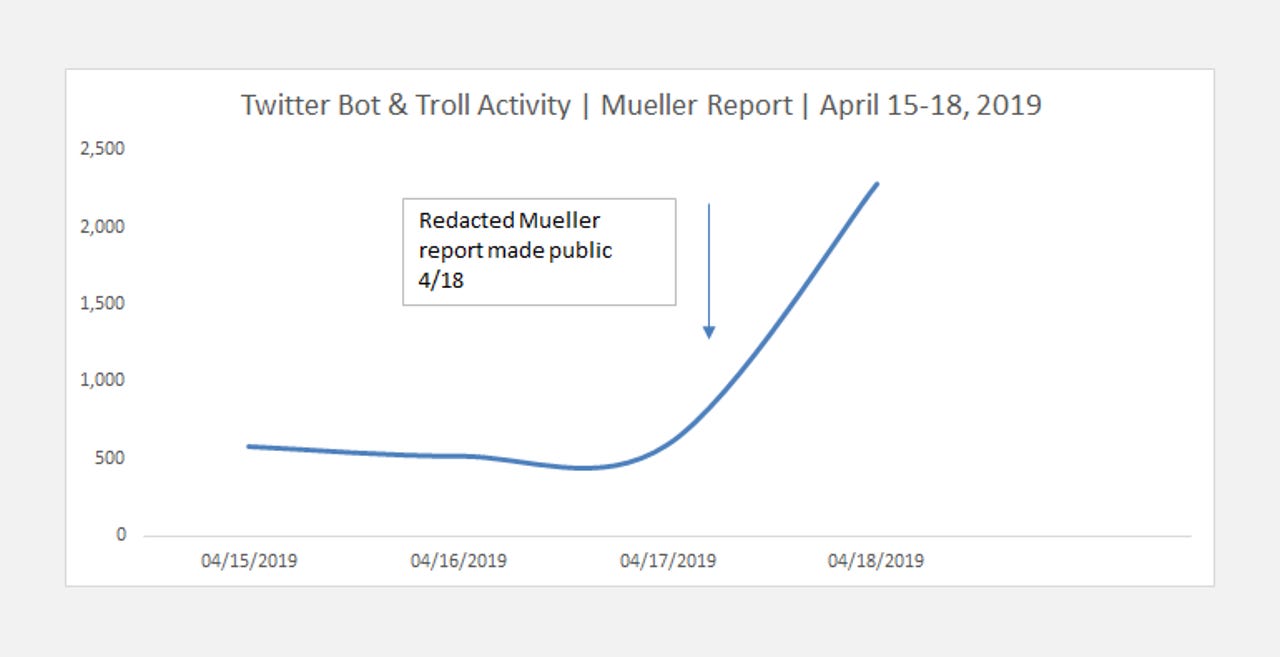Twitter bot activity spiked after the release of the Mueller Report


Security
The activity of Russian-linked Twitter bots and trolls spiked after the release of the Mueller Report, George Kamide, Director at digital risk protection provider SafeGuard Cyber told ZDNet today.
Kamide said his company observed a 286 percent increase in Russian bot and troll activity on Twitter following the public release of the long-awaited Mueller Report.
Dormant bots came to life
The company also noted that the number of unique bots and trolls also increased by 48 percent from the previous day.
This suggests that botnet herders had created thousands of Twitter bot accounts in advance --which they left dormant-- and activated for the release of the Mueller Report, during which they apparently wanted to shape public perception as part of a disinformation campaign.
Mueller Report-related hashtag use from these Russian-linked bots also spiked accordingly, suggesting that they were, indeed, participating in an active opinion-shaping operation, regardless of the opinion they were broadcasting.
According to Kamide, Twitter bot and troll hashtag use increased 852 percent overall, with a 5,000 percent increase in usage for the #mueller hashtag, by far the most popular.
The top five hashtags used were: #mueller, #muellerreport, #trump, #barr, and #russia.
Kamide said SafeGuard Cyber maintains a database of over 600,000 known bots and trolls, a database that is growing every day.
The SafeGuard Cyber director said his company uses 52 risk signatures to classify bad actors into four behavior modes: malicious, suspicious, disinformation, and bot.
"Through proprietary algorithms, manual analysis, and correlation against 155 fact-checking organizations, the company's researchers are able to attribute bot and troll operators to Russia," Kamide told ZDNet. "Using this intelligence, SafeGuard Cyber is able to attribute with a degree of certainty the country of origin of this specific activity. "
The presence of Russian bots on Twitter is indisputable at this point. In October 2018, Twitter released an archive containing over nine million tweets linked to 3,841 accounts the social network had linked to the Sankt Petersburg-based Internet Research Agency, Russia's troll farm and the center of Moscow's political influence campaigns.
In January 2019, Twitter removed an additional 418 accounts linked to other Russian entities.
The company has removed tens of millions of bot accounts across the years, yet its network is still rife with bots, most of which are pushing spam.
Adjust these Facebook privacy settings to protect your personal data
More tech news coverage:
- French government releases in-house IM app to replace WhatsApp and Telegram use
- Facebook admits to storing plaintext passwords for millions of Instagram users
- Some internet outages predicted for the coming month as '768k Day' approaches
- US government has 12,166 data centers with most of them inefficient
- UK to introduce porn age-checks on July 15
- Russia fines Facebook $50 for failing to comply with local data privacy law
- The cord cutting TV dream had another nightmare price hike CNET
- How can businesses save keyboards from becoming obsolete? TechRepublic